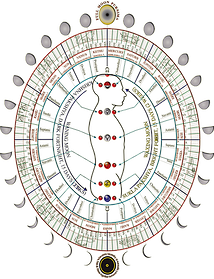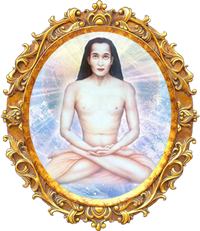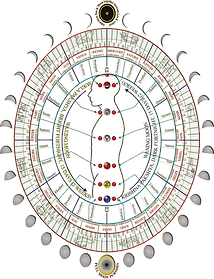

|
|
|||
|
|
|||
|
|
|||
|
|

|
|
||
|
|
||
|
|
||
|
|



|
|
|||
|
|
|||
|
|
|||
|
|

|
|
||
|
|
||
|
|
||
|
|

The teaching of Kriya Yoga is learnt and scaled gradually. It is sectioned or divided into six stages referred to as First Kriya, Second Kriya and so on. The beginner starts with First Kriya. Later, after having practiced for a period of time and if the required level of advancement has been achieved, the person may receive Second Kriya and progress in this manner up through the higher Kriya-s.
First Kriya is the base, the very foundation that allows for progress on the spiritual path. It gives access to knowledge of the body, the Soul and the chakras. It allows for comprehension of the gross body, the astral body and the causal body. It also gives comprehension of the breath and how it functions, as well as its governing laws. The foundation of all other Kriya-s is contained in First Kriya. The techniques, which make it up, are the necessary tools for spiritual life.
Three points are very important in Kriya Yoga:
The above three abilities should ideally be practiced at all times and not just during meditation.
KRIYA TECHNIQUE
Whilst practicing, the body should be perfectly calm and straight, with the head aligned to the body. Prana-shakti enters through the top of the head and between the two eyebrows (bhrukuti) at the upper point of the nose. Then the yogi can acquire knowledge and go beyond knowledge.
Kriya Technique and the Eight Steps of Astanga Yoga
The eight steps of Yoga given in the Yoga Sutras of Patanjali are as follows:
1. Yama - through inner control and self mastery
2. Niyama -rules and regulations regarding inner life
3. Asana -postures/poses
4. Pranayama - breathing techniques-prana -samjama (balance or control of breath)
6. Dharana -concentration, contemplation
7. Dhyana -state of meditation
8. Samadhi- the formless state
The Eight Steps of Kriya Yoga
First Kriya with its different sub-techniques covers the eight steps of Astanga Yoga given by Patanjali.
The correlation between First Kriya and Patanjali’s eight-step Yoga is as follows:
EFFECTS OF THE TECHNIQUE
Kriya Steps 1.1 Guru Pranam and 1.2 Ista pranam (Yama)
The first and second techniques within First Kriya are called pranam and correspond to yama in Patanjali’s Yoga. Yama means to obtain inner control or self control (samyama). Nothing can be controlled from the outside because the root or master key is within our spine. This is why in the first and second techniques we bend the spine forward which allows the magnetic life force to flow and circulate in the spinal cord.
Kriya Step 1.3 Hung-sa Sadhana (Niyama)
The third technique of First Kriya is called Hung-sa sadhana and corresponds to niyama, the second step in Patanjali’s Yoga. Niyama means inner control at the fundamental level, the level of life force and breath. Niyama consists of a number of rules and regulations for spiritual life. The third technique of Kriya Yoga also includes the aum-technique. Aum sadhana is integral to the third technique, but Paramahansa Yogananda treated it as a specific step for the benefit and easier practice of beginners. It is not a new and separate technique, but rather it is one part of the three divine qualities (light, sound, vibration), whereby only the sound is separated. He introduced a posture to help the Kriyaban hear the proper and deep sound of aum by closing the ears with the thumbs and concentrating in the middle of the head. Thus hung-sa sadhana contains the aum-technique.
Hung-sa sadhana is very important for achieving inner control of the functioning of the breath, prana-shakti. Breath affects the pituitary gland (agnya chakra) in two ways through its movement toward the interior during inhalation and its movements towards the exterior during exhalation. The inhalation is called “so”; the exhalation is called “hung”. Condensing this aum-technique is called hung-sa sadhana or practice of hung-sa, which is based on this double movement of breath.
The breath circulates from the top to the bottom, descending from the fontanel to the coccyx down the front side of the spine and then rising up the back of the spine from the coccyx to the fontanel, crossing all the chakras. In this way, niyama (inner control at the empirical level) is accomplished.
Kriya Step 1.4 Mahamudra (Asana)
The fourth step of First Kriya is called Mahamudra (Asana). Asana is the third step in Patanjali’s Yoga. Numerous asanas or physical postures exist in the field of Yoga. Patanjali states that a posture must be calm and pleasant. However, a posture does not happen only on the physical level. Because we always believe in the physical plane of existence we always think of asana as a physical phenomenon. What Patanjali means is beyond the physical plane. Placing attention in the pituitary gland gives us the qualities mentioned by Patanjali about asana. The two lotus petals of the agnya-chakra represent the proper lotus posture of asana. This does not mean with crossed physical legs but rather the metaphorical crossed posture of hung-sa. Thus, these two petals are the proper seat of asana. First, we must open the passage in the spinal column. Mahamudra, the fourth technique in Kriya Yoga opens this passage and allows us to reach and establish ourselves in the pituitary gland. It acts directly upon our spine. This is why it is very efficient and powerful for spirituality. Two nadis (energy channels) called ida and pingala are found inside the spine. They restrict life force on either side and partially prevent it from circulation. Mahamudra helps ida and pingala to open on each side, in turn opening a passage in the middle of the spine called susumna. Susumna does not correspond to any specific nadi. Rather, it is a passage which opens through the practice of mahamudra by pushing apart ida and pingala. Thereafter divine nectar (susumna fluid) can flow down to the bottom of the spine. Unless this passage is opened, life force cannot rise up to the pituitary gland and enter it.
&When this middle passage is opened, the yogi obtains gyana, vigyana and the state of atma-trpta. This results in complete satisfaction at the spiritual level.;
Kriya Step 1.5 “Kriya proper” (Pranayama)
After practicing mahamudra, we practice “Kriya proper”. In Patanjali’s Yoga, “Kriya proper”corresponds to the stage of pranayama. Progressive training in Kriya Yoga comprises six levels called First Kriya, Second Kriya and so forth. When the Kriyaban receives initiation into higher Kriyas, changes occur only in the Kriya part of the meditation. This means that the part of Kriya referred to as “Kriya proper” changes as we advance to higher levels. However, the Kriya meditation techniques which come before “Kriya proper” remain the same throughout all the higher levels of Kriya Yoga. Only the breathing technique changes, bringing the breath towards increasingly subtle and finer levels.
This technique has no connection with practices which require forced retention of breath or with practices that require counting when inhaling, holding the breath and exhaling, thereby trying to force control of the breath.
Pranayama means practicing the breathing technique called “Kriya proper” while remaining in the posture or asana remaining in the pituitary gland or kutastha. The breath is sectioned and then suspended; there is no inhalation, exhalation nor retention.
Kriya Step 1.6 Paravastha (Pratyahara)
According to Patanjali , the step that follows pranayama is pratyahara, complete renunciation, even from breath. Pratyahara means paravastha. By constant establishment in the state of paravastha the three other steps are achieved: dharana-concentration, dhyana-meditation and Samadhi-immersing oneself in the formless state.
When a yogi practices pranayama and obtain samyama, the union of breath through pranayama, then the causal body goes beyond the pituitary gland. In fact the yogi must go beyond the causal body to arrive at dharana, dhyana and Samadhi, the last three steps. When the essence of the gross physical body has withdrawn into the astral body, situated in the spine, then the astral body can withdraw into the causal body. This is the stage called pratyahara. When in pratyahara the causal body rises and crosses the pituitary gland, the yogi experiences Samadhi which is the ultimate result and goal of his practice.
The state of Samadhi is called nirvikalpa Samadhi or the formless state. When it is brought back to the physical level, then the yogi is said to be in the state of savikalpa Samadhi, which means that he is working in the material world without pain or suffering whilst remaining in Samadhi. This is the ultimate aim of our practice.
In Patanjali’s Yoga, one can talk about the steps up to pranayama, but after that it is something very different and beyond description. One he has reached pratyahara the yogi is beyond pranayama and Kriya. Then come dharana, dhyana and Samadhi, which are very close to each other and flow from one to another without any real separation.
The practice should be applied to each field of our life. It is not enough just to achieve the state of becoming, be it even Samadhi. It is essential to bring this state down to the surface on one’s life. When the super-natural energy has descended into all of his actions, then the practitioner will be a super-human amongst all humans.
Kriya Step 1.7 Jyoti Mudra
The seventh and last technique that makes up 1st Kriya is called jyoti-mudra, which means the posture for light or the posture by means of which light is created/produced. In some scriptures, it is referred to as yoni-mudra. The word yoni designates the womb of creation. It is also used to name the female sexual organ. However, in the spiritual context the word refers to brahma-yoni, the divine womb.
The aim of jyoti-mudra is not to see lights or colors during meditation, but to remove darkness and to obtain the light of knowledge in everyday life. This mudra helps to get rid of the bad effects of the planets in the spine through the deep light of meditation.
Jyoti mudra has a deep and direct effect on our astral system, which is situated in the spinal column, from the pituitary gland down to the coccyx and from the coccyx up to the pituitary gland. The planets, the stars and the twelve zodiac signs are found in our six chakras in an ascending and descending order. The nine planets have a specific effect on both the front and back sides of the chakras. From the moment we are born and according to our time of birth, the planets have a specific position in the spine and the good and bad effects are inscribed within it.
Jyoti mudra is a very effective procedure which gives knowledge of the planetary positions. Jyotir veda is the knowledge of jyoti (light). It is also called cosmic astrology. The literal meaning of jyotis (jyoti and isa), is master of the inner astral light. To know jyotis is to know the astral system. Through this knowledge one can find in one’s own astral system the cures and solutions to the problems caused by the planetary positions.
Jyoti mudra allows us to bring the benefits of meditation into our daily life. This is why it is practiced at the end of the KriyaYoga meditation.
CONCLUSION
This is the traditional teaching of Kriya as it has been practiced for thousands of years. Each individual is free to practice as he wishes (although this is not advised or suggested), but there should be no modification of any kind to the Kriya Yoga technique. Nothing should be added, eliminated or modified. This technique is passed on from master to disciple and if each master introduces a modification, then soon there will remain only modified techniques and the true tradition will be lost.
Kriya must be taught directly and in person. The first reason is to ensure accuracy and understanding. The second is to ensure that the disciple does not fall into some of the mental traps and is in fact making real progress.
This original technique is still taught all over the world, and especially in India, by a few masters who respect and sustain the tradition as taught by Sri Yukteswarjee.